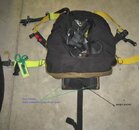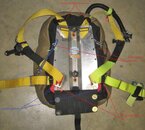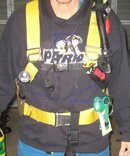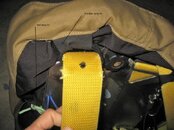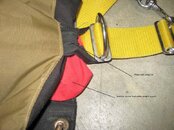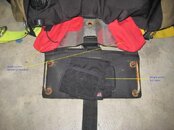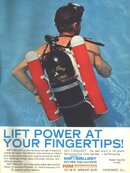I was waiting until I had a chance to take photos of my BP/W which has several of the debated items on it, but I'll just try to post the pictures later (if there is interest).
First the disclaimer: I am not an engineer, just a talented experimentalist.
ZIPPERS are a common way of getting into the case and accessing the bladder. My Dive Rite wing has one on the inside perimeter. My DIY wing has one also on the inside perimeter, and one of my first DIY wings had velco, then zippers, on the end. My commercially bought inflatable kayaks have longitudinal zippers and my DIY cataraft tubes have circumferential lacing as the closure. In over 15 years of using at least one of these I have found no problems at all.
BLADDER SUBSTANTIALLY LARGER THAN THE CASING can lead to air trapping. On my first DIY wing I had this problem. This led me to start making my own bladders from scratch. How big is too big? I don't know. Reducing the tube diameter of a wing by an inch or even maybe two shouldn't give a lot of air trapping. I doubt that more than 2 inches is needed, probably more like only an inch. I make my bladders deliberately about 1-2 inches larger in diameter than the casing. The bladder is to hold the air. The casing the pressure. I have not found an air trapping issue with this size difference. I guess I can un-zip my DIY wing and my Dive Rite wing and see how much they expand fully inflated with the zippers loose.
BUNGEES can reduce the uninflated profile. They have 2 problems. First they add drag. Second, if they are too tight or too few, they can cause air trapping. Try strapping down a wing to make it into a sidemount rig and you will see the problem.
MY SOLUTION(S):
Standard single BM configuration:
I use a fairly standard non-branded SS backplate and a DIY STA with a single tank with the attach bolts permanently fixed. My harness is webbing with D-ring pivots on the arm straps at axilla level. A chest strap attaches to these pivot D-rings. Above the pivots is a single fixed D-ring on each side. Below is a velco closure inside a sleeve as a protected quick release. The sleeve acts as a knife holder (left) and back-up light holder (right) and prevents accidental release of the strap. The arm straps are continuous with the waist strap. Each side of the waist strap has a single fixed D-ring. There is a 4# capacity weight pouch mounted on the back of the plate and secured by the arm/waist strap as it threads through the bottom slots (one each side). These are usually empty. I have added a butt plate (semi-soft) to the bottom of the plate with straps/book screws. The crotch strap threads through the butt plate for additional security. The butt plate has 2 angled 2-1/2" door handles and a center 5# capacity weight pocket (also usually empty). The waist strap secures with a standard SS weight belt cam buckle. The crotch strap attaches to the left side of the waist strap with a 1-1/2" side release fastex buckle. The crotch strap shortens with a simple pull.
Sidemount or BM with pony or BM with left SM (independent doubles)
A short length of bungee and dog clip that secures on the plate behind each axilla and clips to the upper chest D-ring or pivot D-ring. This bungee hooks over the sidemount tank valve or the pony valve. When not in use the dog clip is attached to the side waist D-ring. The lower clip on the SM tank or Pony clips to one of the door handles on the butt plate.
The wing is prevented from tacoing by sewing 2" wide elastic loops (4 in all) into the wing casing seams where the shoulder straps and waist straps are. A smaller (1") elastic loop is sewn into the side seam opposite one of the side plate holes. These loops allow the wing casing to attach to the shoulder straps, side of the plate, and waist straps. Check out the SMS75 and SMS100 SM systems. They do the same thing, and no I didn't steal from them - we came up with the idea independently.
The only problem I have with this is there is too much air near my shoulders and not enough in my low back. I really like the zipper to make the casing smaller idea and will probably put one on each side on the top half of my DIY (and primary) wing.
This is a long winded and wordy description. Here are some pictures. This works well for me.
